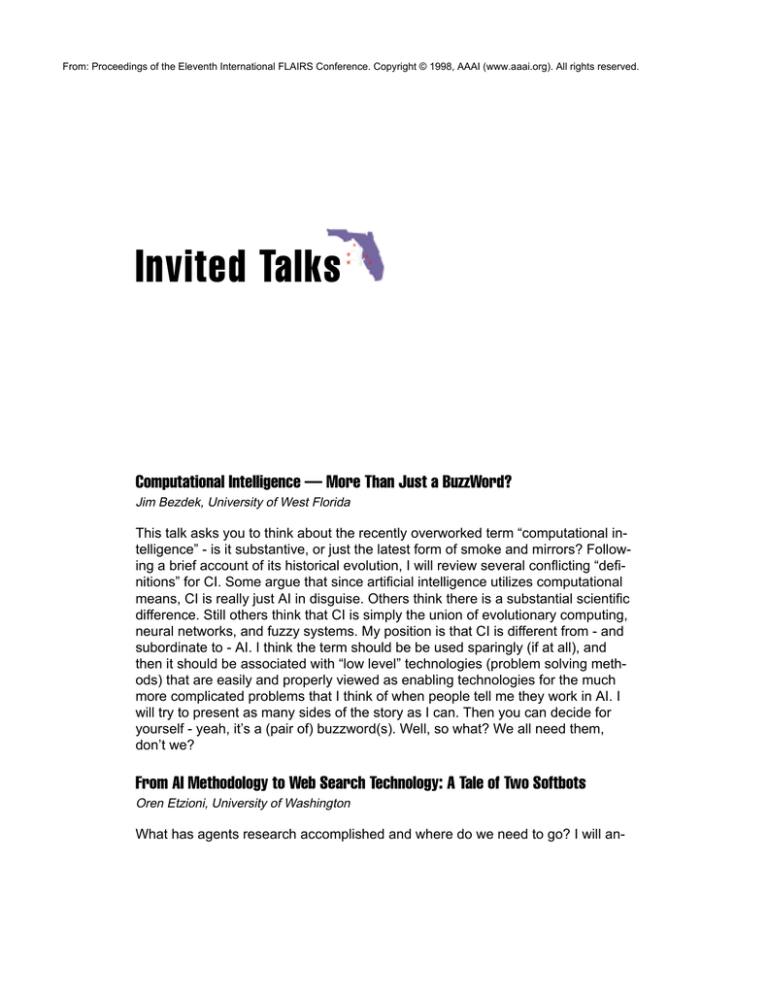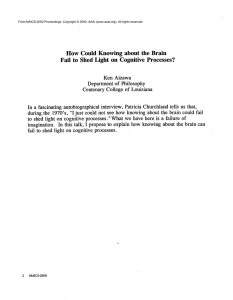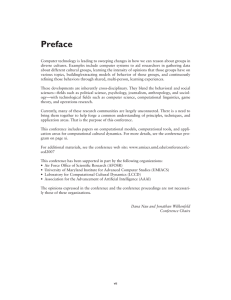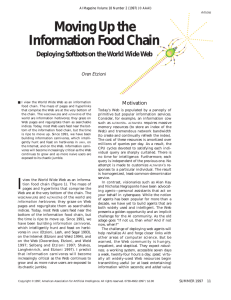
From: Proceedings of the Eleventh International FLAIRS Conference. Copyright © 1998, AAAI (www.aaai.org). All rights reserved.
Invited Talks
Computational Intelligence — More Than Just a BuzzWord?
Jim Bezdek, University of West Florida
This talk asks you to think about the recently overworked term “computational intelligence” - is it substantive, or just the latest form of smoke and mirrors? Following a brief account of its historical evolution, I will review several conflicting “definitions” for CI. Some argue that since artificial intelligence utilizes computational
means, CI is really just AI in disguise. Others think there is a substantial scientific
difference. Still others think that CI is simply the union of evolutionary computing,
neural networks, and fuzzy systems. My position is that CI is different from - and
subordinate to - AI. I think the term should be be used sparingly (if at all), and
then it should be associated with “low level” technologies (problem solving methods) that are easily and properly viewed as enabling technologies for the much
more complicated problems that I think of when people tell me they work in AI. I
will try to present as many sides of the story as I can. Then you can decide for
yourself - yeah, it’s a (pair of) buzzword(s). Well, so what? We all need them,
don’t we?
From AI Methodology to Web Search Technology: A Tale of Two Softbots
Oren Etzioni, University of Washington
What has agents research accomplished and where do we need to go? I will an-
From: Proceedings of the Eleventh International FLAIRS Conference. Copyright © 1998, AAAI (www.aaai.org). All rights reserved.
swer these questions by telling the story of two softbots: Rodney (1991— 1997)
is an early softbot that relied on a declarative action representation and on a novel algorithm for planning (and acting) with incomplete information to satisfy a
wide range of high-level user requests; Jango (http://jango.excite.com) is a popular shopping assistant able to access hundreds of on-line stores in over fifteen
product categories. Both softbots enable a person to state “what” she wants accomplished, the softbot is responsible for “how” and “where”. Their limitations
suggest directions for future work for both academia and industry.
Cognitive Prostheses
Kenneth M. Ford,* Patrick J. Hayes and William J. Clancey,* University of West Florida
(* Currently on leave to NASA Ames Research Center)
The emerging concept of human-centered computing (HCC) represents a significant shift in thinking about intelligent machines, and indeed about information
technology in general. It embodies a “systems view,” in which human thought and
action and technological systems are seen as inextricably linked and equally important aspects of analysis, design, and evaluation. This framework focuses less
on stand-alone exemplars of mechanical cognitive talent, and is concerned more
with computational aids designed to amplify human cognitive and perceptual abilities. Essentially these are cognitive prostheses, computational systems that
leverage and extend human intellectual capacities, just as the steam shovel was
a sort of muscular prosthesis. The prostheses metaphor implies the importance
of designing systems that fit the human and machine components together in
ways that synergistically exploit their respective capacities. The design and fit of
these computational prostheses seems to require a larger interdisciplinary range
than has traditionally been associated with AI work, including computer scientists, cognitive scientists, and social scientists of various stripes. This shift in perspective places human/machine interaction issues at the center of the subject.
The “system” in question isn’t “the computer” but instead includes cognitive and
social systems, computational tools, and the physical facilities and environment.
Thus, HCC provides a new research outlook, with new research agendas and
goals. This new perspective seems to be more productive than the traditional
‘Turing test’ vision to define the central aims of AI technology.
Designing Intelligent Agents Using Markov Decision Processes
Sridhar Mahadevan, Michigan State University
A fundamental question of artificial intelligence is how to design “intelligent
agents”: computational entities immersed in a dynamic environment, which can
perceive their surroundings using sensors, and want to take actions that maximize task performance. Mobile robots, softbots, game playing programs, and industrial controllers can all be viewed as instances of intelligent agents. In this
From: Proceedings of the Eleventh International FLAIRS Conference. Copyright © 1998, AAAI (www.aaai.org). All rights reserved.
talk, I will describe one of the currently most popular frameworks for writing agent
programs. This framework is based on a probabilistic model of sequential decision-making called Markov decision processes (MDP). An eclectic community of
researchers have adopted the MDP model, both within various subfields of AI,
such as machine learning, robotics, decision-theoretic planning, and multi-agent
systems, as well as outside AI, such as neural brain modeling, operations research, and psychology. I will illustrate the power (and limitations) of the MDP
framework using several case studies from my own research, in domains ranging
from mobile robotics to flexible manufacturing.
Learning to Improve Efficiency and Quality of Planning
Ray Mooney, University of Texas at Austin
Since almost the beginning of AI planning research, learning methods have been
employed to decrease search and improve efficiency. Most techniques have
been based on what became known as explanation-based learning (EBL), in
which knowledge-based analysis of individual examples is used to construct generalized plans or search-control rules. However, such techniques are prone to the
utility problem, in which too much overly-specific and ineffectively-utilized knowledge can actually decrease efficiency rather than improve it. One effective approach to this problem is to combine EBL with inductive learning in order to acquire more general and effective control knowledge. For example, we have developed a system, SCOPE, which uses a combination of EBL and Inductive
Logic Programming to learn search-control rules for a partial-order planner. Detailed experimental results in several domains, including a fairly complex production manufacturing task, demonstrate that it can significantly improve both efficiency and plan quality. This talk will review our recent work in this area as well
as comment on the past, present, and future of research on learning and planning, and on the general issue of increasing the interaction between machine
learning and other areas of AI.






